Fort Scott Make America Great Again Ballistic Gel Results
7.62x39mm Gel Test - 7 Loads Put to the Test
James Tarr tests seven 7.62x39mm loads fired from a 1969 Polish AKM into gel blocks to see only how well they actually perform.

August 26, 2020
This commodity originally appeared in Firearms News Baronial 2020 Issue 16. Pick up a copy to read more than articles like this ane.
While the AR-15 is undeniably America'south darling, there are now more AKs in apportionment in this land than ever before, and about of them are chambered in the original vii.62x39mm cartridge.
While the 7.62x39 is considered the "intermediate assault burglarize cartridge against which all others are judged," few people actually know what kind of functioning they can expect from the cartridge out of an AK.
For this article, I decided to test seven vii.62x39mm loads, some similar, several very different. I chose them based on a number of factors — availability, price, and (advertised) functioning. My ammo list included American Eagle FMJ, premium defensive ammo from Winchester and Hornady, and steel-cased Russian-fabricated ammo from Wolf and Barnaul. My plan was to measure velocity, accuracy, and terminal performance using ballistic gel blocks.

Group Therapy
The AR-15 is an inherently more accurate design than the AK. The average accuracy across the board for commercial ARs currently being made in this country is 1.ii MOA, which is outstanding. When it comes to AKs, most guns will practise 3–four MOA, depending on ammo, which is more than than adequate accuracy for both defensive and hunting use at the distances you should be using this cartridge.
Withal, information technology is shooting upward to that accurateness potential of the AK which is the challenging part — if you're just using the iron sights. The sight radius on the AK is short, nigh the same every bit on an old-schoolhouse CAR-fifteen … simply nobody is running iron sights on their ARs whatever more. Heck, nigh ARs don't even come with iron sights, whereas every AK does. However, more and more AKs are set from the mill with the ability to mount optics. A number of aftermarket companies offer optic-mounting options for AKs equally well, either on the handguard or on the rear sight base, if your gun doesn't have a telescopic mountain track.
While I own iii AKs, only 1 of them is even set up from the manufacturing plant to accept a scope, and I wasn't convinced of its accurateness potential — and I wanted to utilise a scope, as shooting groups with atomic number 26 sights would be more of a referendum on my aging eyes than it would exist a exam of the ammo.
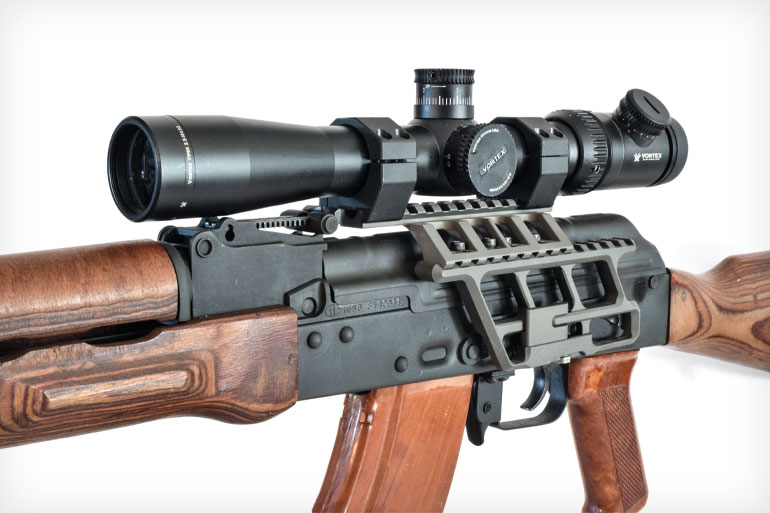
Luckily, I alive close to RS Regulate, makers of the best AK scope mounts in the globe, and borrowed one of their AKs to do accurateness testing. I had my choice of several different rifles, and chose a "standard" AK that should show typical accuracy potential. In this case, the AK was made in 1969 in Poland, which at the time was a Warsaw Pact state, which makes it a true Commie AK. Information technology currently sports laminated wood furniture as well every bit an RS Regulate scope mount, onto which was attached a Vortex Viper 2.5-10X scope. 10X is more than enough for the accurateness part of this testing.
Dissimilar with .223/5.56 loads, there isn't a broad variation in bullet weights in vii.62x39. The lightest bullet tested was the Winchester PDX1 at 120 grains, and the heaviest were the 125-grain softpoint loads from Wolf and Barnaul.
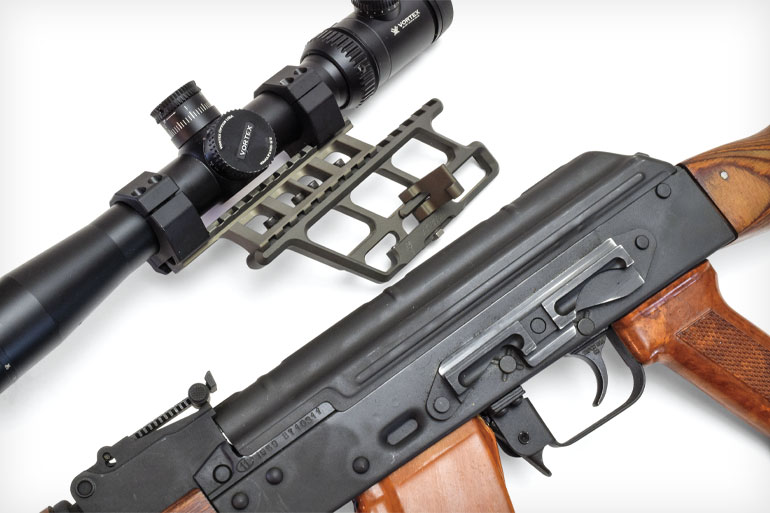
To measure the velocity of the ammunition I used my Oehler Model 35P chronograph. This chrono takes a few minutes to set up, simply and so it is an absolute tank and provides consistent accurate results.
If you lot check out the accompanying table you'll come across that except for the historically slow Hornady load, all the remaining loads tested ran within 100 fps or and so of each other. The standard deviation for about of the loads was unmarried digits, which is outstanding. Assume your 7.62x39mm load will throw a 123–125-grain bullet downrange effectually ii,400 fps, and you lot'll be right almost every time.
The Barnaul HP, the Hornady SST, and the American Eagle FMJ provided the best accurateness, all producing 2.5 MOA groups or less, but in that location was not a widespread disparity. The "worst" groups were withal right around 4 MOA, which is perfectly acceptable for an AK. The unmarried best group I fired was a ane.fifty" smoker with American Eagle FMJ, which I could not replicate. And a reminder — your gun may shoot far differently with the same armament.
Recommended
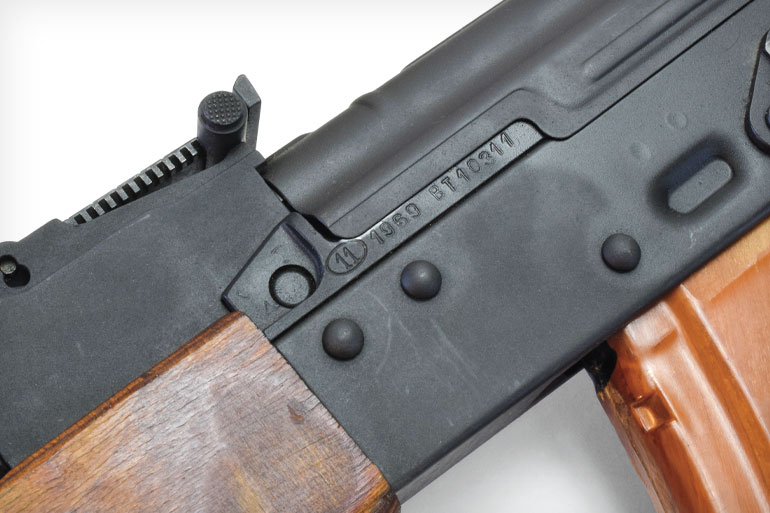
There's Always Room For Jell-O
Empirically, yous could argue that the best way to exam the final performance of armament was to shoot diverse people with information technology and discover the results. This has really happened (we learned a lot about the effectiveness of the 5.7x28 cartridge on people after the Fort Hood terrorist attack for case), merely generally hither in America nosotros frown on fatal human testing.
Animals are a decent substitute, pigs especially, but you run into the same problem you exercise with people — neither people nor animals accept the same construction throughout their bodies. Ane bullet may striking a rib and get deflected. Some other may miss the ribs but hit the liver. One may go through a lot of muscle earlier hitting bone. Musculus, intestines, organs, all have different densities and resistance to bullets.
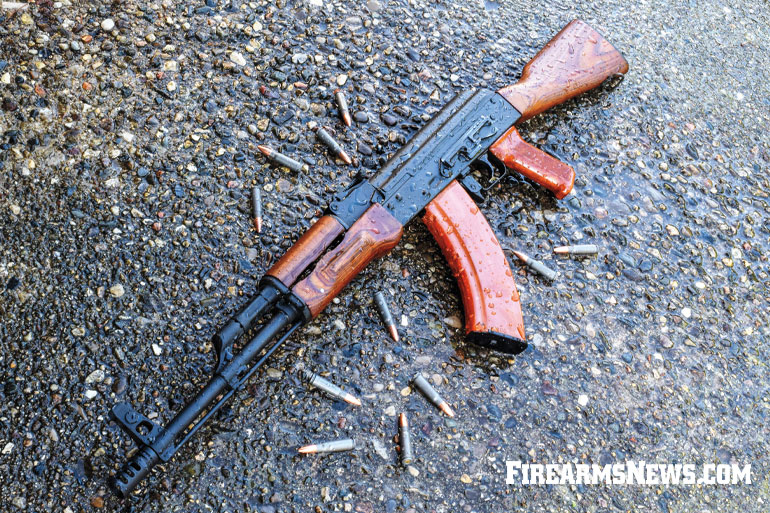
In the 1980s, the idea of using ballistic gel as a tissue simulant became popular. Ballistic gel is just that — edible gelatin, nonetheless mixed in a ratio to make it much thicker than your average Jell-O dessert. The FBI standardized ten% ballistic gel as a good tissue simulant, which y'all make by adding one pound of powdered gel to nine pounds of h2o. The FBI even came up with a procedure to make up one's mind if the gel met the proper spec — shoot a steel BB into it from an airgun, travelling at a certain average velocity (590 fps +/- thirty fps), and if that BB penetrated the gel cake a certain distance (8.five cm), information technology was a properly calibrated gel cake.
Gel blocks allow you lot to compare apples to apples — the cake is the same every time, so the only variable is the bullet performance. No artificial simulant is going to provide you an exact match to people, but 10% ballistic gel is more often than not considered a adept "rough approximate" at human flesh.
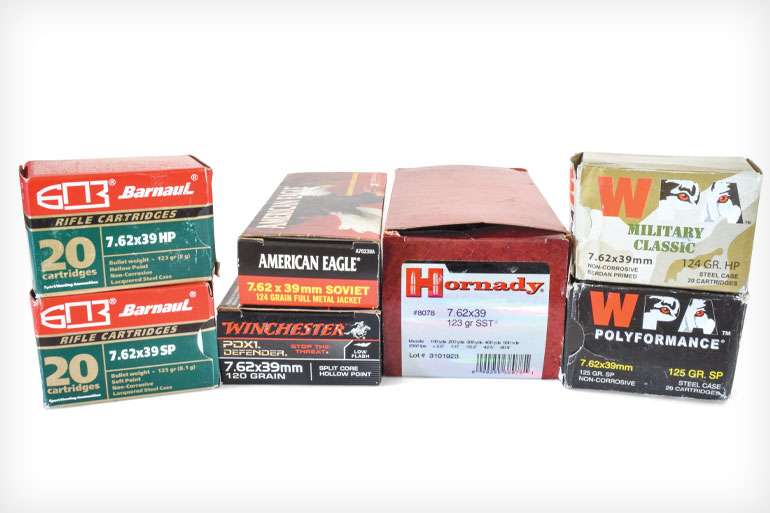
When it comes to bullet functioning in gel blocks, the FBI designed a specific protocol around testing bullets, but they were originally merely concerned with handgun bullets, as few FBI Special Agents at the time were issued rifles, and nobody was concerned about the "stopping power" of rifles. All the same, their penetration recommendations for handgun bullets are worth keeping in listen — you want a minimum twelve inches of penetration to reliably hitting the bad guy's organs from any angle, and any penetration over xviii inches more often than not increases your chances of the bullet going through the bad guy and hitting an innocent bystander.
For this article, I used Clear Ballstics blocks. These blocks are actually polymer, not gelatin, but formulated to provide similar performance to FBI-spec gel blocks. Extensive testing has shown that bullets fired into these blocks expand the same as they do standard gel blocks, but on boilerplate penetrate 10% more deeply. Keep that in mind as y'all look at my results.
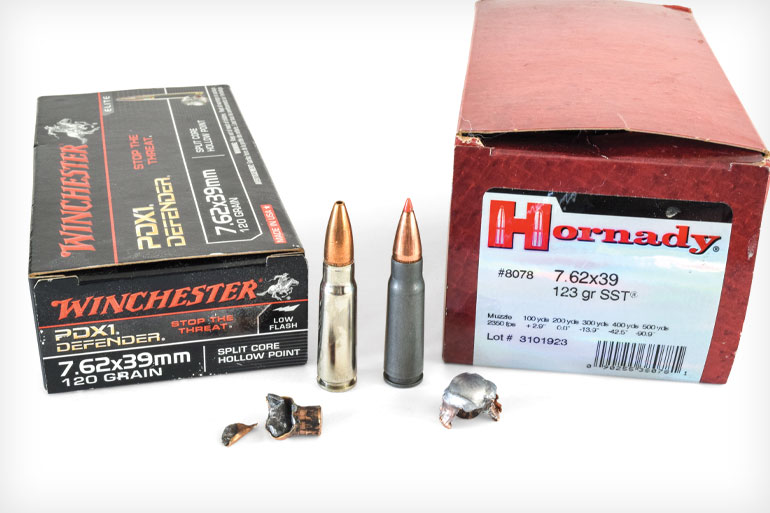
For testing I first fired bullets from each of the seven chosen loads into bare blocks. If a bullet doesn't perform well in bare blocks it won't perform well, period. After that I fired bullets into blocks covered with the FBI's "heavy clothing" bulwark, which consists of a layer of denim over a cotton/poly sweatshirt over two layers of cotton fiber shirt material. Clothing, as thin as it is, tends to slow downward the expansion of bullets passing through it, and this test is of import as about bad guys you'll meet will be wearing article of clothing.
The Clear Ballistics blocks are each roughly 16 inches long, then I laid several blocks terminate-to-end when testing burglarize ammunition.
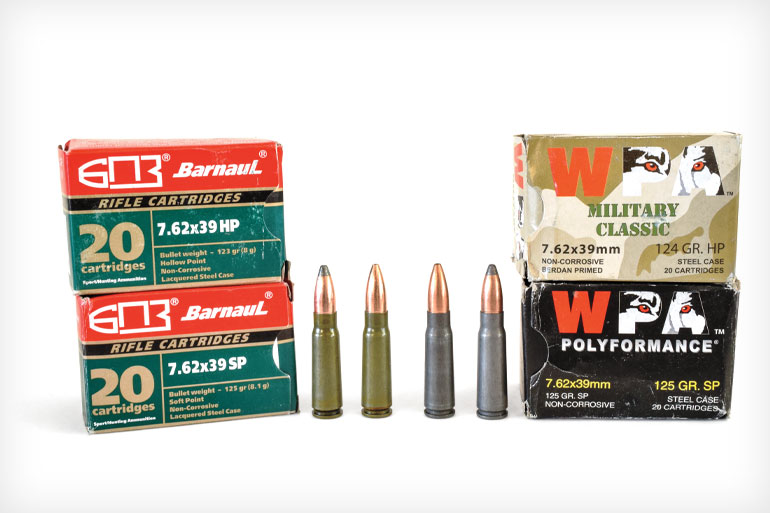
Tale of the Tape
Offset up for testing was the American Hawkeye 124-grain full metal jacket load. FMJ loads provide a nice baseline confronting which the operation of "expanding" bullets can be measured. And, honestly, a lot of people like FMJ ammo for certain purposes, such as punching through barriers.
Through the barrel of my borrowed semi-custom AK the AE 124-grain FMJ load provided an boilerplate two,368 fps. The bullet penetrated the blank block 31.25-inches, virtually reaching the cease of the second block. Recovered weight of the bullet was 118.viii grains, or 95.8%.
A quick bated — as the bullet zipped right through the starting time block and into the second, not as much energy was dumped into the first block, but withal it jumped off the table. Handgun bullets, when fired into gel blocks, rarely make the heavy blocks do more than wiggle. Rifles, on the other hand, are dumping far more energy into the blocks, and yous'll find they often jump several inches into the air, frequently loftier enough to fall correct off the support table. Considering each block weighs roughly eighteen pounds, this is impressive.
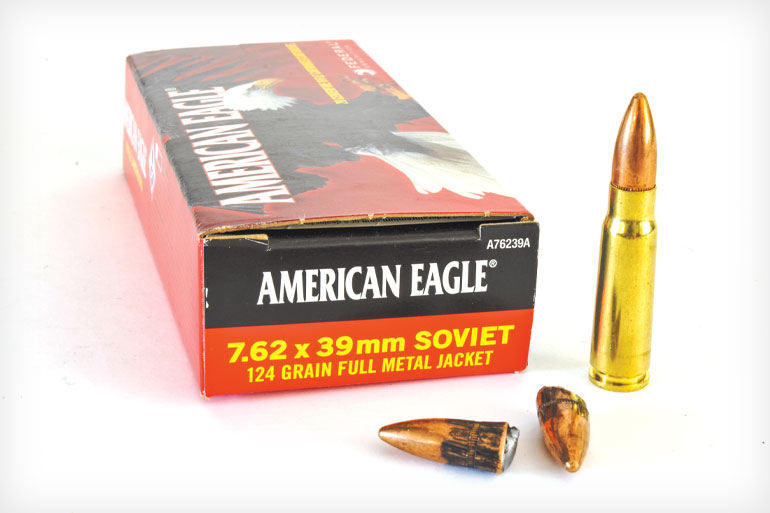
When y'all watch this in deadening movement you lot'll see it'due south because the bullet, impacting at fast rifle speeds, causes a large "temporary wound crenel" inside the block, often stretching it far beyond its original dimensions. This temporary wound crenel, acquired by overpressure and hydrostatic shock, is why rifles are far more than effective fight stoppers than handguns. Handgun bullets just don't travel fast enough to cause it — it more often than not requires velocities over 2000 fps.
I had to cutting off a corner of my lead block so, when I picked information technology up, I knew the orientation it had been in prior to jumping around or off the table. The recovered bullet was flattened and slightly aptitude. This flattening of the bullet happens later initial penetration — the bullet starts to yaw and travel sideways, which deforms it. This is common, and often causes it to shoot out of the block at an angle (and I will admit this happened to me, I had to fire a few rounds before I got i that stayed completely in the cake).
The good thing most FMJ bullets is that they are the least affected by barriers. When fired through the heavy clothing barrier into the cake, the bullet penetrated 31-inches and displayed a flattened shape, retaining 118.v grains (95.5%) of its weight (nearly identical performance).
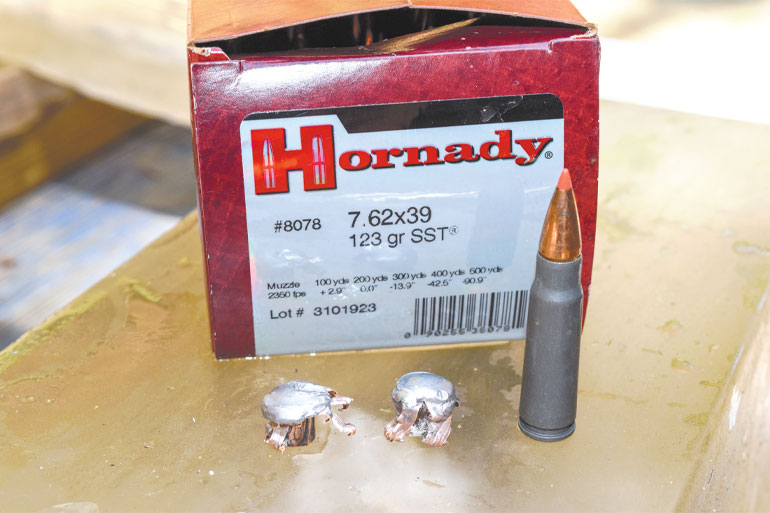
The 123-grain Hornady SST (Super Daze Tip) bullet is simply about the opposite in construction to a tough FMJ bullet. The SST bullet has a crimson polymer tip sitting in a hollow-indicate bullet, and is loaded into a steel instance. The lead cadre is mechanically bonded to the jacket to keep them together after impact. Upon touch that tip is designed to be pushed into the hollow indicate, expanding it apace.
The Hornady load provided 2,291 fps, the slowest of all loads tested. In bare block the bullet penetrated 21.75 inches and expanded to .70". The recovered bullet weighed 110.4 grains, which meant it retained 89% of its weight.
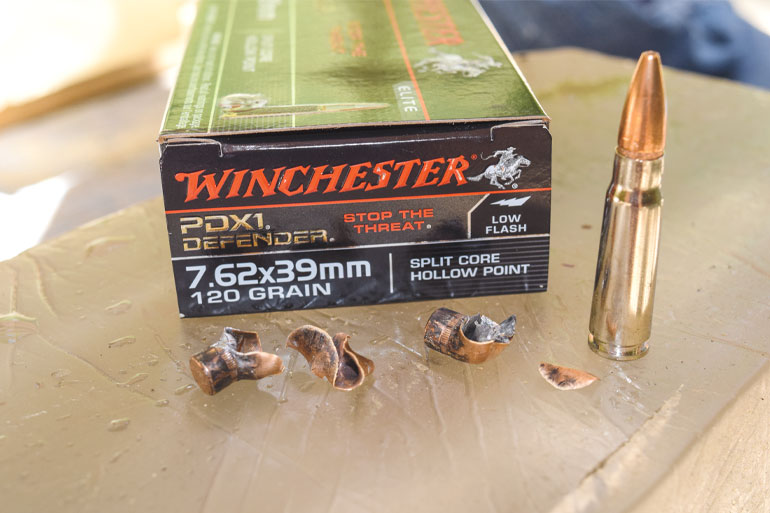
When fired through the vesture barrier, the bullet penetrated the block 23.5 inches. The recovered bullet had an expanded diameter of .66" and a total recovered weight of 112.3 grains, or xc.5%. This is excellent performance. These bullets performed a lot similar traditional handgun hollowpoint bullets — good expansion, with the jacket peeling back but not separating from the lead cadre.
Next up for testing was the Winchester PDX1 Defender load. This 120-grain bullet is a divide-core hollow-point design and designed specifically for personal defense confronting two-legged predators. Upon bear upon the front half of the bullet is designed to expand and/or fragment while the base penetrates securely, giving y'all both expansion and penetration. The base atomic number 82 is bonded to the jacket.
Out of the loaner AK the Winchester load provided two,340 fps. In bare cake the bullet performed as designed — a big chunk of the front of the bullet jacket (weighing 12.9 grains) peeled off and penetrated xix inches. The base, weighing 66.v grains and .53" in diameter, penetrated 25.v-inches. Total recovered weight of the base and jacket fragment was 79.6 grains or 66%.
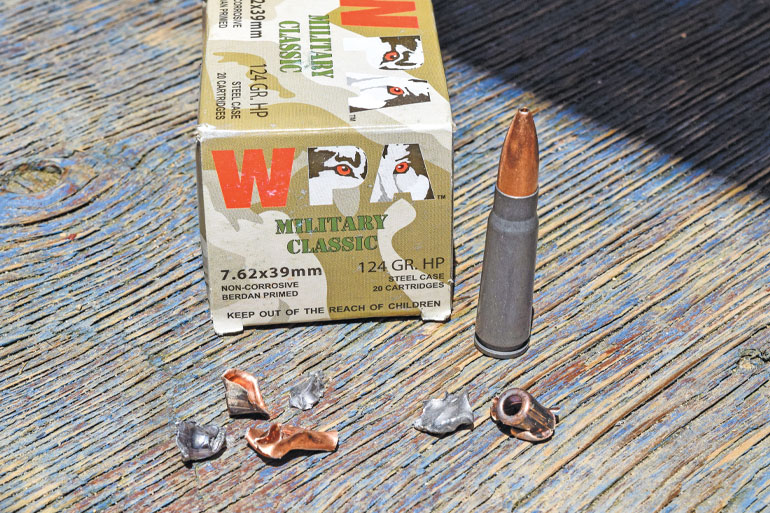
When fired through the wear bulwark the PDX1 bullet penetrated 27 inches. One pocket-sized fragment broke off the nose and penetrated 26 inches. The base weighed 102.0 grains and expanded to .54". The fragment weighed iii.iv grains. Total recovered weight of the bullet and fragment was 105.3 grains, or 87.7%. These recovered bullets are ugly, only they are performing exactly equally intended.
Wolf's Military Classic load features a 124-grain HP bullet loaded into a steel case. This load chronographed at 2,456 fps. Testing showed me this bullet has a thin jacket and a relatively soft pb cadre, and expansion was explosive. Only tracking down all the $.25 and pieces in the ballistic blocks was ofttimes problematic.
In bare block the lead cadre of the bullet penetrated 18 inches, deeper than any of the other fragments. The copper jacket around the base of the bullet separated from the atomic number 82 core and just penetrated xi inches while expanding to .46". Total recovered weight of the bits big enough to observe and recover was 72.vii grains, or 58%.
When fired through heavy article of clothing into the block the lead core separated from the jacket and penetrated 21.v-inches. The jacket effectually the cadre and several other lead fragments penetrated 12 inches. The jacket expanded to .58", and total recovered weight of pb and jacket was 83.1 grains, or 67%.
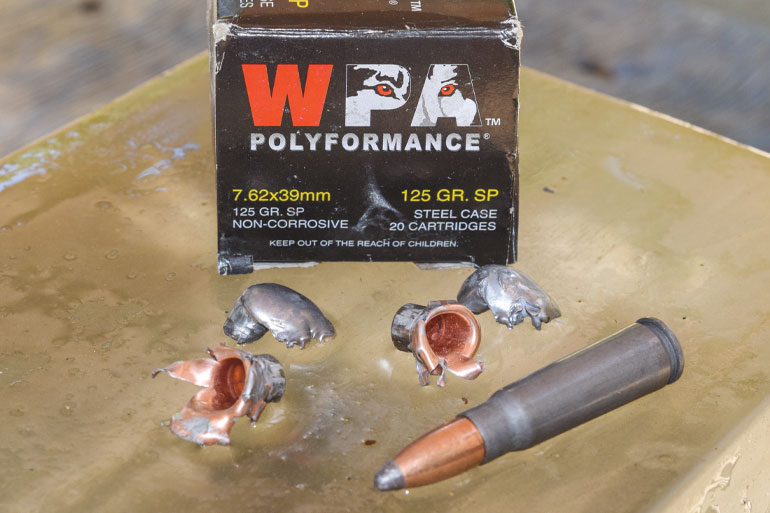
If you want violent expansion and fragmentation, and arent' that interested in penetration, barrier or otherwise, this seems to be the load for you.
Adjacent upwardly was the Wolf Polyformance load, which offers a 125-grain soft point bullet in a steel case. "Soft bespeak" bullets, which show exposed lead tips above jackets, are some of the original expanding rifle bullets — they're simple, just they work. This load produced ii,447 fps.
In the blank block the jacket separated from the atomic number 82 cadre. The lead core/base penetrated 18 inches. The jacket penetrated 12.5 inches, and had an expanded diameter of .64". The recovered base weighed 85.3 grains, and full recovered weight of the bullet was 114.iii grains, or 91.4%.
Through heavy clothing the jacket again separated from the lead core. The atomic number 82 cadre/base of operations penetrated 21 inches and had a recovered weight of 81.4 grains. The jacket expanded to .60" and penetrated 15 inches. Total recovered bullet weight was 109 grains, or 87.2%.
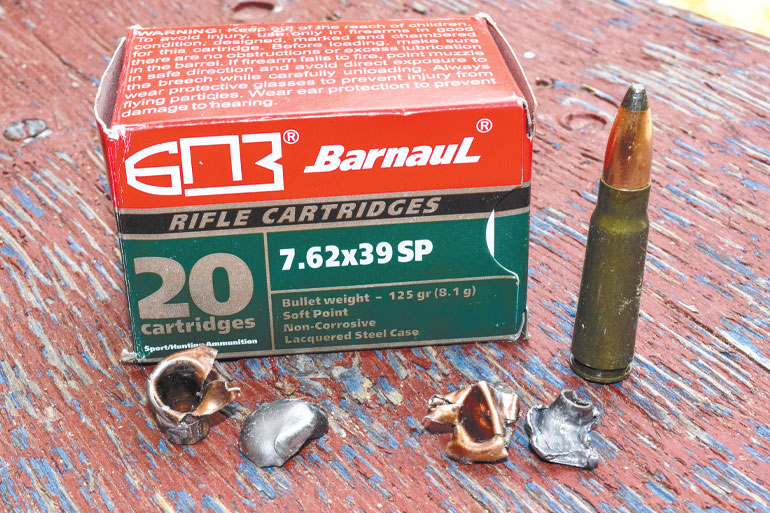
A reminder — I was testing these bullets on blocks twelve feet away. At farther distances the bullets would be travelling slower, and that reduced velocity will event in less expansion/fragmentation and probably deeper penetration.
As many people who ain AKs tend to prefer steel-cased strange-fabricated ammo for its affordable price, in addition to the Wolf ammunition above I decided to test two lacquered steel-cased loads fabricated by Barnaul, made in Russia (every bit is the Wolf armament). First up from Barnaul was a 125-grain SP, which provided two,487 fps. In bare cake the jacket separated from the lead core. The lead core, weighing 83.iii grains, penetrated 17.5-inches. The jacket peeled off and only penetrated 12.5-inches, with an expanded diameter of .62". Total recovered weight of the cadre and jacket was 113.seven grains, or 91%.
When fired through the habiliment barrier the jacket and core again separated, just they stayed together far longer. The jacket penetrated xvi inches, and the lead core penetrated 17.v inches. The lead core weighed 75.ix grains, and total recovered weight of the jacket and core was 103.half-dozen grains for 83% weight retentiveness.
Finally I tested a 123-grain HP load from Barnaul. It provided 2,475 fps. In a bare block the jacket separated into two large pieces which penetrated 12.75–13.5-inches. The atomic number 82 core continued on, penetrating 24.five-inches. The recovered core weighed 61.3 grains and had a diameter of .59%. Total recovered weight of jacket/cadre was 113.3 grains, or 92%.
When fired through the heavy wear barrier the 123-grain HP bullet virtually exploded, with multiple pieces of pb and jacket penetrating betwixt 12.v- and 15.v-inches. Full recovered weight of the bullet pieces was 116.9 grains, or 95%.
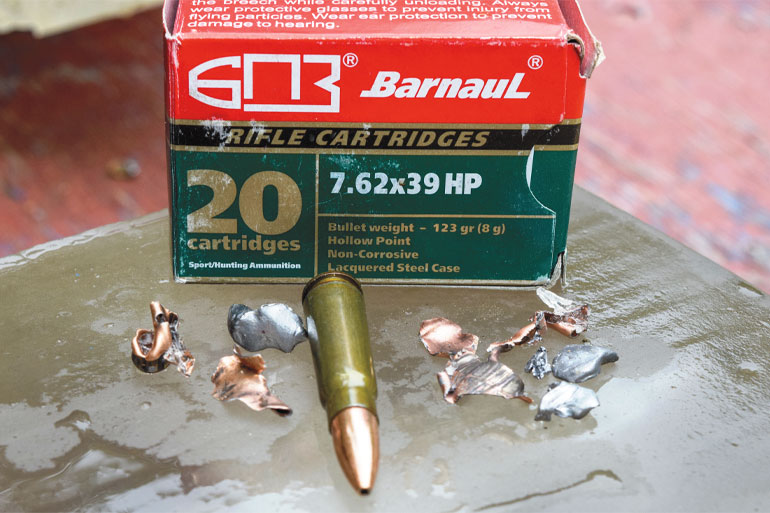
Overview
The accurateness results showed me that the commercial ammunition either being fabricated in this state or imported from Russia is of solid quality. I have heard horror stories virtually ammo made in certain countries that you lot'll never see hither (Republic of iraq for example), but when it comes to the stuff you can get here, information technology seems to exist consistent. And with the availability and low cost of newly manufactured 7.62x39mm ammo you won't really demand to purchase whatsoever "surplus" ammo of dubious quality.
Plus, because AKs are more than popular, most American ammunition manufacturers make at least i 7.62x39mm load.
Equally for the ballistic block tests, in that location did not seem to be much difference in performance whether in blank blocks or blocks covered with vesture. This is not the example when testing handgun ammunition, but I call back the horsepower of the rifle round simply overpowers what little resistance the clothing layers have.
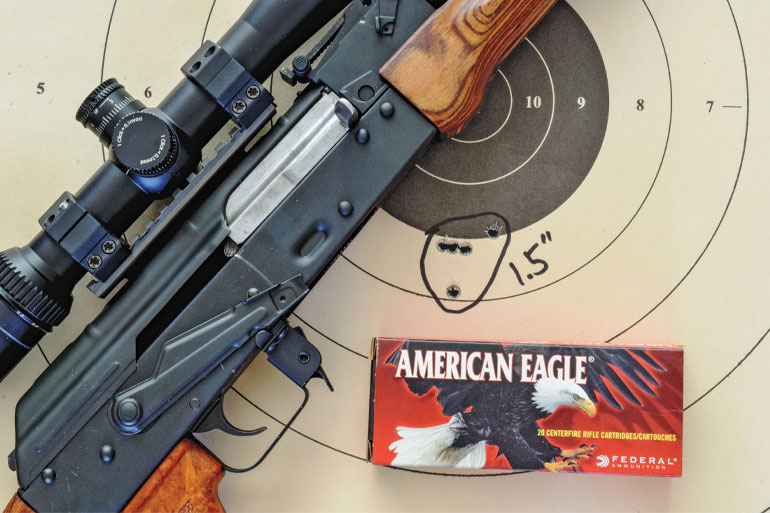
I think the tests showed exactly what a bonded core is supposed to do. The Hornady SST bullets did not shed their jackets, expanded, and penetrated deeply. Too deeply, in fact, if you're worried about shoot-throughs in an urban setting. The Winchester PDX1 bullets performed exactly equally advertised — the front end half of the bullet fragmented, and the bonded base continued on, penetrating deeply.
The jackets of both the Wolf and Barnaul bullets are not bonded to the cores, and as a upshot they tend to split up. The jackets peel off and penetrate a foot or and so, while the cadre (or well-nigh of it) penetrates more deeply. This is truthful whether it is a soft-point or hollowpoint bullet, although the HP bullets tended to fragment more violently. If you desire as much of your bullet's energy dumped into the first 16 or so inches of target, and aren't worried about intermediate barrier penetration, Wolf or Barnaul HP bullets might be for you.
If you want a load with performance between the Hornady bonded core and the Wof/Barnaul bullets, the Winchester PDX1 load seems to provide a squeamish rest betwixt penetration and fragmentation.
The simple FMJ bullets to me provided very interesting results. Because the 7.62x39mm bullets are not that heavy for caliber, and for rifle bullets are non travelling very fast, they did non penetrate every bit deeply as I was expecting. Nonetheless, yous will note that the bullets penetrated over thirty inches, which means if you similar FMJ bullets for their ability to penetrate barriers, if y'all happen to shoot a bad guy with them that bullet will nix right on through him and keep on going.
7.62x39mm Ammo — Test Burglarize: 1969 Smoothen AKM

7.62x39mm Bare Cake Testing

seven.62x39mm Heavy Vesture-Covered Block Testing

Source: https://www.firearmsnews.com/editorial/762x39mm-gel-test-7-loads-put-to-the-test/383856
0 Response to "Fort Scott Make America Great Again Ballistic Gel Results"
Postar um comentário